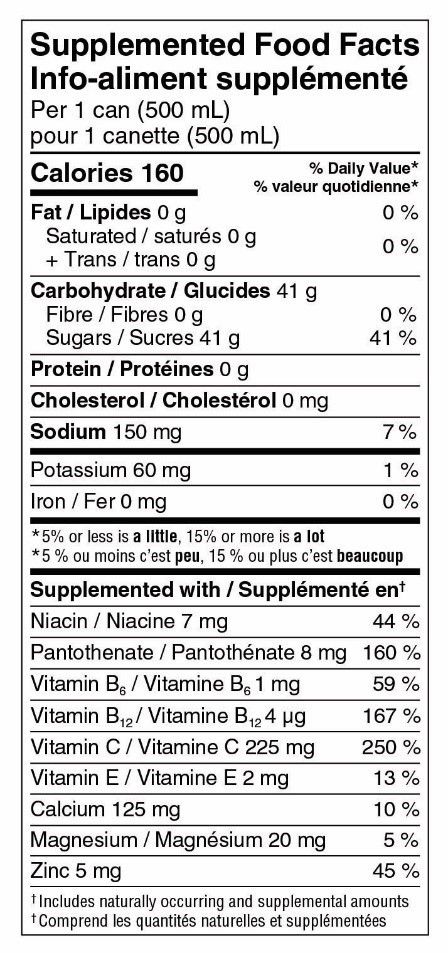- within Insurance and Law Department Performance topic(s)
- with Senior Company Executives, HR and Inhouse Counsel
- with readers working within the Banking & Credit, Business & Consumer Services and Insurance industries
Recently, the federal government introduced a Regulatory framework for supplemented foods via amendments (the "Amendments") to the Food and Drug Regulations (FDR) (the "Regulations"). The framework establishes maximum amounts per serving for supplemental ingredients, prescribes cautionary statements and caution identifiers to be placed on the labels of supplemented foods, and requires display of a Supplemented Food Facts Table.
Background
Health Canada defines supplemented foods generally as "prepackaged foods with added vitamins, minerals, amino acids and/or other ingredients such as caffeine." Examples of supplemented foods include beverages with added minerals, caffeinated energy drinks, and snack bars with added vitamins.
Prior to the Amendments, no specific regulatory framework for supplemented foods existed in Canada. Instead, since 2012, Health Canada had been authorizing the sale of supplemented food products solely on a case-by-case basis through the issuance of Temporary Marketing Authorizations ("TMAs"). As explained in the Regulatory Impact Analysis Statement that accompanied the Amendments, the TMA framework had been criticized by stakeholders for being inflexible and unpredictable, and for posing a barrier to innovation.
The Amendments
Scope
The Amendments generally apply to prepackaged foods belonging to one of the food categories set out in the List of permitted supplemented food categories and to which a nutrient or other substance set out in the List of permitted supplemental ingredients has been added. Each of these lists are incorporated by reference in the Regulations, and stakeholders can request additions, removals or modifications to the lists, thus providing a more predictable path to market for innovative supplemented foods. The submission process is outlined in the Health Canada guidance document for the supplemented foods framework, and future guidance will set out detailed data requirements.
Certain food categories, such as alcoholic beverages, most foods fortified with vitamins and minerals for public health purposes (e.g. milk to which vitamin D is added), and foods intended for consumption by infants or women who are breastfeeding or pregnant, are excluded from the definition of supplemented foods, due to the higher risk they pose to consumers. These foods will continue to be regulated under existing provisions of the FDR.
Restrictions on use of supplemental ingredients
For each supplemental ingredient included in the List of permitted supplemental ingredients, the List sets out:
- the food categories to which the supplemental ingredient may be added;
- the maximum amount permitted per serving of stated size;
- the cautionary statements required on the label and the threshold level above which these statements are required; and
- any other conditions of use, including additional labelling requirements.
Cautionary statements and caution identifiers
Cautionary statements set out in the List of permitted supplemental ingredients are specific to the ingredient (and in some cases, the food category) in question, and may vary depending on the amount of the ingredient. For example, if the amount of caffeine declared on the label of certain water-based beverages is more than 79 mg per serving, a cautionary statement advising the consumer not to drink more than X servings per day is required, where X is the maximum number of servings which does not exceed 400 mg of caffeine.
Supplemented foods that carry cautionary statements must also prominently display a standardized supplemented food caution identifier on the principal display panel of its label. Reproduced below is the bilingual standard format of the caution identifier.

Supplemented Food Facts Table
The Amendments require a modified Nutrition Facts Table called the Supplemented Food Facts Table on the label of supplemented foods. This table includes a "Supplemented with" heading for declaring the absolute amount of each supplemental ingredient, and an interpretative statement explaining that amounts of supplemental ingredients declared include both naturally occurring and supplemental amounts. Health Canada has provided the following example of a Supplemented Food Facts Table in the bilingual standard format.

Representations
The Amendments restrict certain representations on the labels of or in advertisements for supplemented foods. For example, it is prohibited to make a health claim about a nutrient if the nutrient is a supplemental ingredient for which a cautionary statement is applicable, unless the claim is accompanied by a statement or claim about the specific action or effect of the nutrient. As a further example, if a supplemented food is required to carry a "high caffeine content" cautionary statement, it is prohibited to make a health claim about a vitamin or mineral nutrient contained in the food.
Existing provisions of the Regulations with respect to representations about a food will generally apply to supplemented foods as well.
For more information
Health Canada has developed a guidance document for the supplemented foods framework, which is available on request.
Timelines for Compliance
The Amendments came into force on July 21, 2022. Supplemented foods that are already marketed under a TMA, or for which a TMA application was submitted before July 21, 2022, must comply with the new framework by January 1, 2026. However, new supplemented foods must comply immediately.
The content of this article is intended to provide a general guide to the subject matter. Specialist advice should be sought about your specific circumstances.




